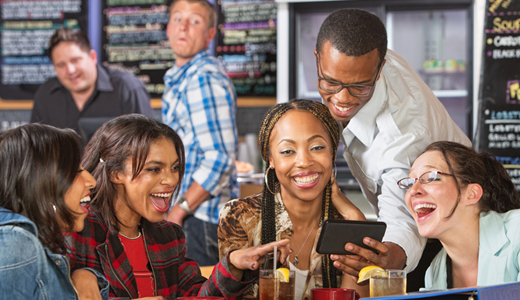I got a text from my twentysomething daughter the other day that responded to a message I had sent with a “hahaha.” And being at that time of the afternoon where my brain desperately seeks out anything to settle on other than the work before me, I got to thinking about her seemingly laugh-out-loud response. Surely, I reasoned, my little quip didn’t deserve a full out milk-spew, did it? Wouldn’t a much more low-key “haha” or maybe a twittering “teehee” have been more appropriate?
And before you start to judging, you should know that my “e-laughter” rumination is not some unique venture for mankind. Even Facebook recently decided to study its users and see exactly how they expressed themselves in the arena of written-out giggles and guffaws. And they found some interesting habits.
Facebook researchers discovered that the majority of posting chortlers—51.4%—used “haha” for their laughing expression of choice. About 34% were into laugh emoji of some round open-mouthed stripe or another. A good 13% really got into “hehe.” And that old teenspeak staple “lol” is still currently being used by some old guy in Phoenix named Fred.
That’s cool and all, but it still didn’t answer my question about the triple-“ha” my daughter used. What is the proper etiquette in e-message land? So I started looking around for a solid defining correlation between the use of the h-word and it’s true meaning. I didn’t find much other than a Los Angeles Times article by Michael Krikorian that suggested that, “haha” and the dusty, “LOL,” are “texting’s go-to replies, a vaguely complimentary, vaguely condescending way to acknowledge a text has been received.”
According to Krikorian, then, you’d be just as likely to get a meaningless and standard “haha” for saying you had stumbled and broken a collarbone as you would for saying anything actually funny. And that started feeling much more appropriate in the case of my daughter’s response, since most of my jokes usually feel a bit more like a kick to the shin-bone than a tickle to the funny one.
But there was still that additional “ha.”
Could there be a hierarchy of sorts for the “ha”? Where, say, one “ha” is an insult—as in, “yeah that was almost funny”? Two represent an obligatory acknowledgement, three “ha”s mean a slight grin of amusement, four equal a full laugh and an outrageous “hahahahaha” or more means “take me to the ER, I think I’m going into convulsions”?
We haven’t even really considered the “hehe,” “hee-hee” or the “heh heh” responses. Are those equivalent to snickers and eye-rolls? The more you type the heartier the roll? Or for that matter, is that “heh heh” closer to a Gru-like rub-your-hands-and-glower sort of mirth? If you rendered a “hee-haw” in your email, would that be saying something derogatory about you, the backwoods hee-hawer? Do you actually need to be Santa Claus to use a “ho-ho-ho”?
The more I thought on it, the more I realized that this new age of e-ha and e-hee was beyond my ken. To really understand the meaning of the various written out chuckles and cackles, I’d need to ask a Millennial. Only they would be in on the true code. So that night I asked my daughter what her response to my joke had meant. Was it an actual laugh or some lesser or greater variation? And she replied … “What joke?”
Ha.






Recent Comments